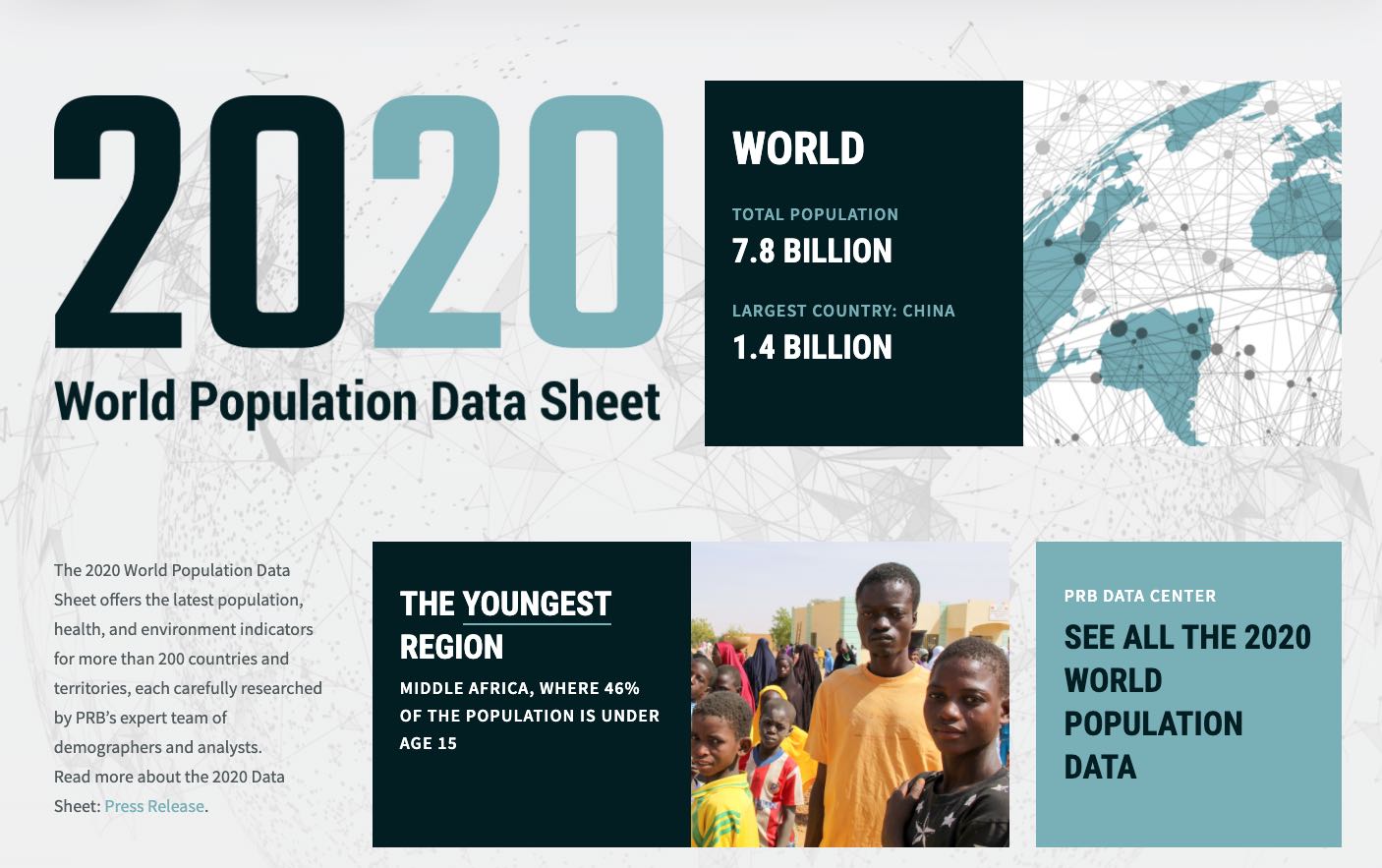
WASHINGTON, D.C. —Older adults ages 65 and older now account for 9% of global population, in part because of declining fertility rates. This fact is one of the insights from the 2020 World Population Data Sheet released today by Population Reference Bureau (PRB) in advance of World Population Day (July 11). In 91 countries and territories—nearly 45% of the world’s population—total fertility rates are below replacement level, the average number of children at which a population exactly replaces itself from one generation to the next in the absence of migration. And in 21 countries and territories, including several that have suffered devastating loss during the COVID-19 pandemic, people ages 65 and older account for at least 20% of the population.
This trend is most pronounced in Europe and East Asia. In contrast, many countries in sub-Saharan Africa and some in Asia continue to experience rapid population growth and high fertility rates. The population of 25 countries is expected to at least double between 2020 and 2050.
Published since 1962, PRB’s annual World Population Data Sheet tracks global population data. This year’s edition provides 24 population indicators for more than 200 countries and territories. Users can also explore key trends through an interactive map.
“As the experience with the COVID-19 pandemic has shown us, population changes such as aging and rapid urbanization are important factors for countries to consider as they plan for future disease outbreaks, long-term health care needs and other developments,” said Jeff Jordan, PRB president and CEO. “PRB’s World Population Data Sheet provides objective data and analysis policymakers need to make these decisions.”
Among the key findings for 2020:
- The world population is projected to reach 9.9 billion by 2050, an increase of more than 25% from 2020.
- The global total fertility rate is 2.3 births per woman, while the replacement level is 2.1 births per woman.
- Western Europe and Southern Europe have the largest shares of people ages 65 years and older (21%), while sub-Saharan Africa has the smallest share (3%).
Other findings in the 2020 World Population Data Sheet:
AGE
- Women’s life expectancy at birth is highest in Hong Kong (88) and lowest in Central African Republic (55). Life expectancy at birth for men is highest in Australia (83) and lowest in Central African Republic and Lesotho (51). Among the regions, Eastern Europe has the largest gap in life expectancy between men (69) and women (79).
- The United States ranks 50th out of all countries and territories for male life expectancy at birth—tied with countries including Oman, Turkey and Panama—and 49th for female life expectancy at birth—tied with countries including Albania, Argentina and Lebanon. At 76 years and 81 years respectively, life expectancy at birth in the United States is four years lower than in Canada for males and three years lower than in Canada for females.
- Sub-Saharan Africa has the youngest population of any region, with 43% of its population under age 15. In contrast, 14% of Southern Europe’s population is under age 15.
POPULATION CHANGE
- Angola and Benin are projected to grow by at least 150% of their current population between 2020 and 2050, while Niger’s population is expected to increase by almost 175%.
- Thirty-eight countries and territories, including Armenia, Germany and South Korea, are projected to have a smaller population in 2050 than in 2020.
FERTILITY
- Niger has the highest total fertility rate (7.1 average births for each woman), followed by Mali (6.3) and the Democratic Republic of the Congo (6.2). Some of the lowest total fertility rates are in South Korea (0.9), Taiwan (1.0) and Singapore (1.1).
URBANIZATION
- At 84%, South America has the highest percent of the population living in urban areas of any region.
- In 12 countries and territories, at least 50% of the population lives in cities with a population of 1 million or more, including Republic of the Congo (63%), Australia (62%) and Israel (61%).
Click here to request the 2020 World Population Data Sheet.
Contact: Liselle Yorke, 202-939-5463
PRB informs people around the world about population, health and the environment, and empowers them to use that information to advance the well-being of current and future generations. Find out more at www.prb.org. Follow us on Twitter @PRBdata.
PACE: Policy, Advocacy, and Communication Enhanced for Population and Reproductive Health
Ensuring that family planning, reproductive health, and population issues are key for sustainable and equitable...
USAID

 ">
">




